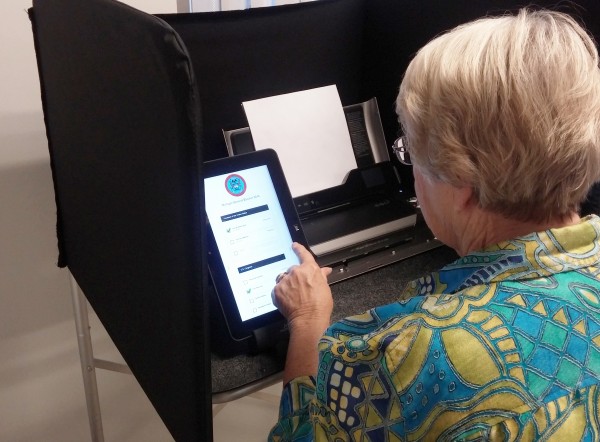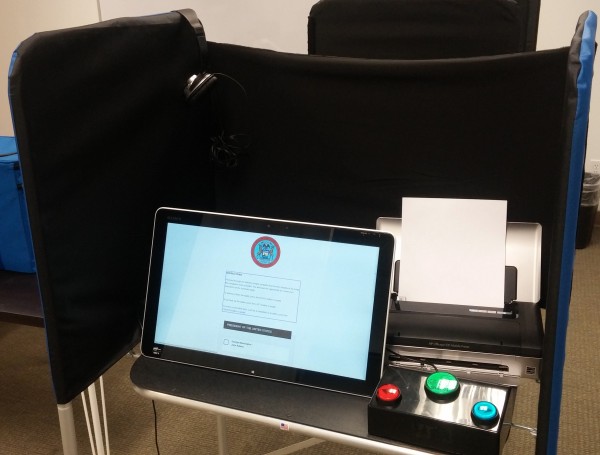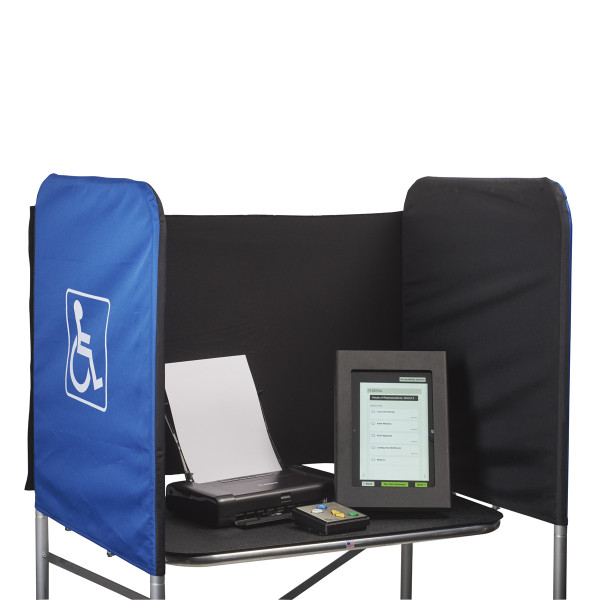Writer: Tiffany Whisner, Coles Marketing
The right to vote is a basic human right. It is one that has been fought for throughout U.S. history, and it gives each person the opportunity to voice his or her opinion in a meeting, discussion, debate or election campaign.
And 2016 is an election year. A big one. There is the possibility of the first woman president in Hillary Clinton, and Donald Trump is the GOP frontrunner. As with all presidential elections, things are heating up, and the drama comes with each debate.
For some people though, casting a vote for the Leader of the Free World isn’t just as easy as walking into a designated polling location, waiting in line and filling out a ballot.
Life, liberty and the pursuit of accessibility
 “Accessible voting means that all voters have access to voting a ballot in complete privacy, regardless of disabilities or other barriers,” said Nicholas Coudsy.
“Accessible voting means that all voters have access to voting a ballot in complete privacy, regardless of disabilities or other barriers,” said Nicholas Coudsy.
Coudsy is the solutions engineer for Everyone Counts, an organization founded to bring today’s modern technologies to elections, making them more secure, accessible, auditable and reliable. When the organization first began, according to Coudsy, it focused on improving voting for the most underserved voters — military serving overseas and voters with disabilities.
“Prior to accessible voting technologies, many voters with disabilities had to vote primarily by telling somebody who was able to fill out a physical paper ballot, read and pull a lever, or punch a hole in a punch card voting machine how they would like their vote cast, thus losing the privacy of their choices and having to trust that the person cast the ballot the way the voter intended,” Coudsy said.
As part of the Voting Rights Act of 1965 (VRA), election officials are required to allow a voter who is blind or has another disability to receive assistance from a person of the voter’s choice, other than the voter’s employer or its agent or an officer or agent of the voter’s union.
But the lack of accessible voting leads to an even lower voter registration and turnout, which is historically low in general.
“Voter registration and the voting process wasn’t done with accessibility in mind,” said Rob Carr, accessibility coordinator for Oklahoma ABLE Tech. He provides expertise on functional and technology accessibility, accessibility policy and institutionalizing accessibility.
“Now as online voter registration is making its way across the county, moving that piece of the voting process onto the Web is making it more convenient for people to become engaged and increase their participation, especially those people with disabilities,” Carr said.
According to the Brennan Center for Justice at New York University School of Law, “Already, forty- states and the District of Columbia have moved forward with important elements of voter registration modernization, including electronic registration at DMVs, online registration, Election Day registration and portability. Additionally, many states are considering ways to modernize their systems.”
“Currently, some states allow for online voter registration using accessible websites, and many are also translated in other languages,” Coudsy said. “Any process that moves away from paper to the Web greatly increases accessibility due to the fact that many people with disabilities have computers that are already outfitted with screen readers and other assistive tools.”
“The idea is that with anything online, including voting, people with disabilities won’t face the barriers when they try to use it that they may when physically going to a polling place,” Carr said.
“For people with disabilities having the accessibility of an online voting registration tool, it might allow and encourage more people with disabilities to go ahead and register to vote,” he said. “It brings the voting process to them, and the hope is for any barriers to fall away and, therefore, offer a big benefit and powerful impact to that marginalized group.”
All polling places are not created equal
“Accessibility is important not only for casting your vote but also in the actual polling place and getting there,” Carr said. “Public transportation isn’t always accessible, so just getting to the voting place can be challenging. And there may be dozens of polling places in your area, but some of them may be in more accessible locations than others.”
The Americans with Disabilities Act (ADA) Checklist for Polling Places notes requirements for parking, passenger drop-off areas, sidewalks and walkways as well as the hallways of the polling location and the accessibility of the actual voting area.
 “Depending on their disability, reading forms, understanding the language, filling out paper forms and accessing physical polling places can all be challenges, especially for someone with low vision or poor motor skills,” Coudsy said.
“Depending on their disability, reading forms, understanding the language, filling out paper forms and accessing physical polling places can all be challenges, especially for someone with low vision or poor motor skills,” Coudsy said.
“Polling places that are not already accessible will have temporary measures in order to do so,” Carr said. “There’s certainly a broad awareness and efforts made to make things accessible. Everyone needs to be included and as independent as possible, but the length we go to can be very different when it comes to locations and what options are available.”
“Like in a built environment, we have ramps and curb cuts and elevators and doors of a particular width, and with technology devices and resources, we also want to be sure we have similar accessible features, just done virtually,” Carr said. “It’s important to remember where we might think of providing a paper ballot in an alternate format, like Braille, that when we talk about technology and accessible voting that we also have the opportunity to provide websites in a PDF format so many more people can consume and use them and, therefore, become more independent and involved in all aspects of voting.”
“Persons with disabilities have the right to have one accessible voting device in each U.S. polling place that should accommodate most voters with disabilities,” Coudsy said. “Most of these machines currently do not address voters that are deaf-blind. U.S. polling places also have ADA requirements to meet for physical accessibility for things like booth height and room access.”
“And in the vast majority of cases, voters with disabilities do not have a way of voting accessibly from home, as paper is still the primary means for voters to vote absentee (or from home), and paper voting is not easy or always possible for those with visual or motor impairments,” he continued. “Only a few counties in the nation provide a means for forms of accessible absentee voting, such as allowing voters to vote from home using their own accessible computers or telephones as opposed to paper. Providing a non-paper option for voters who need to vote at home would be a great step forward in terms of improving this process.”
And then there’s the point of making sure poll workers are informed of accessibility features available and are knowledgeable of how to help people with disabilities take advantage of those options.
“Poll workers usually are volunteers and have a great deal of responsibilities to execute over a very long day,” Coudsy said. “Assisting people with disabilities may not be something they are used to in their everyday lives, so extra training specifically on how to help voters with disabilities is always a good idea.”
“You’re relying on a volunteer workforce, and they don’t volunteer in this capacity very often,” Carr said. “Election boards get a lot of flak, and while there are certainly some things that could be done better, there are also a lot of moving parts. While there shouldn’t be complete reliance on poll workers to know about the accessibility of a voting machine, an election board certainly should emphasize training poll workers on accessibility features that might be available. There should also be a focus on getting the word out to people who actually need to use the equipment.”
The freedom to use assistive technology
Carr and the Oklahoma ABLE Tech program were involved in research with the Association of Assistive Technology Act Programs (ATAP), as noted in a webinar from the RESNA Catalyst Project.
“We were in a unique position to engage the voting consumers, giving assistive technology demonstrations and letting folks know this technology is out there to help make it easier and more convenient for them to vote,” Carr said.
The research involved collecting data to find out whether or not providing these demonstrations and training on accessible voting equipment would increase a voter’s ability to go to the polling place and use the equipment even if there wasn’t anyone at the polling place who knew how to use the equipment.
“Helping do the demonstrations really brought me a lot of insight into the process,” Carr said. “It was a hands-on look at what it’s really like at the polling places. While poll workers may not always know how to use the equipment, many of the people with disabilities didn’t know the technology was even available. They are comfortable in how they have always voted in the past, and we need to do more to make them aware of what technology is available to help them.”

For example, Everyone Counts provides a variety of accessible means of voting. In the polling place, there is an accessible voting device outfitted with an audio tactile interface. A voter can listen to an audio ballot in a variety of languages and navigate that ballot using button devices and other accessible tools. Voters can use the tools in conjunction with a touch-screen interface.
In addition to the audio-tactile features, the software of the device provides for a variety of text increase and contrast features as well as the ability to blackout the screen for confidence that their voting session is in private.
And for those voters at home, they can use a touchtone phone or the Internet.
“Many voters with disabilities are more tech savvy than voters without disabilities — technology has enabled users of all types to interact with the Internet with screen readers and other assistive devices,” Coudsy said. “Everyone Counts brings the ballot to the voter and allows them to mark it using the tools they already have set up on their own devices.”
And training on the assistive technology for voting shouldn’t come from the poll workers on Election Day. Technology needs to be updated and built into new voting machines and websites from the beginning.
“How can we work together with the election boards, assistive technology programs and advocacy groups to create more inroads to the audiences we want to reach? How can we help the state and county election boards raise the level of awareness of this assistive technology to consumers? It’s a slow process, but we are expanding the awareness level one step at a time,” Carr said.
There should also be support for people using the assistive technology at polling places to have extended time on Election Day and other expanded voting options in order to use accessible voting machines effectively.
“In general, we need to get more young people, both with and without disabilities, to vote,” Carr said. “That will affect some change with more focus on self-advocacy both at a primary and secondary education level. Voting, and everything else, should be accessible. It’s complex, and it’s going to take a lot of us to do it — but we are moving in the right direction.”
And Coudsy advances that ideal. “Ensuring the right to a secret ballot for every U.S. citizen, regardless of disability or ability, is the foundation of our democracy.”
